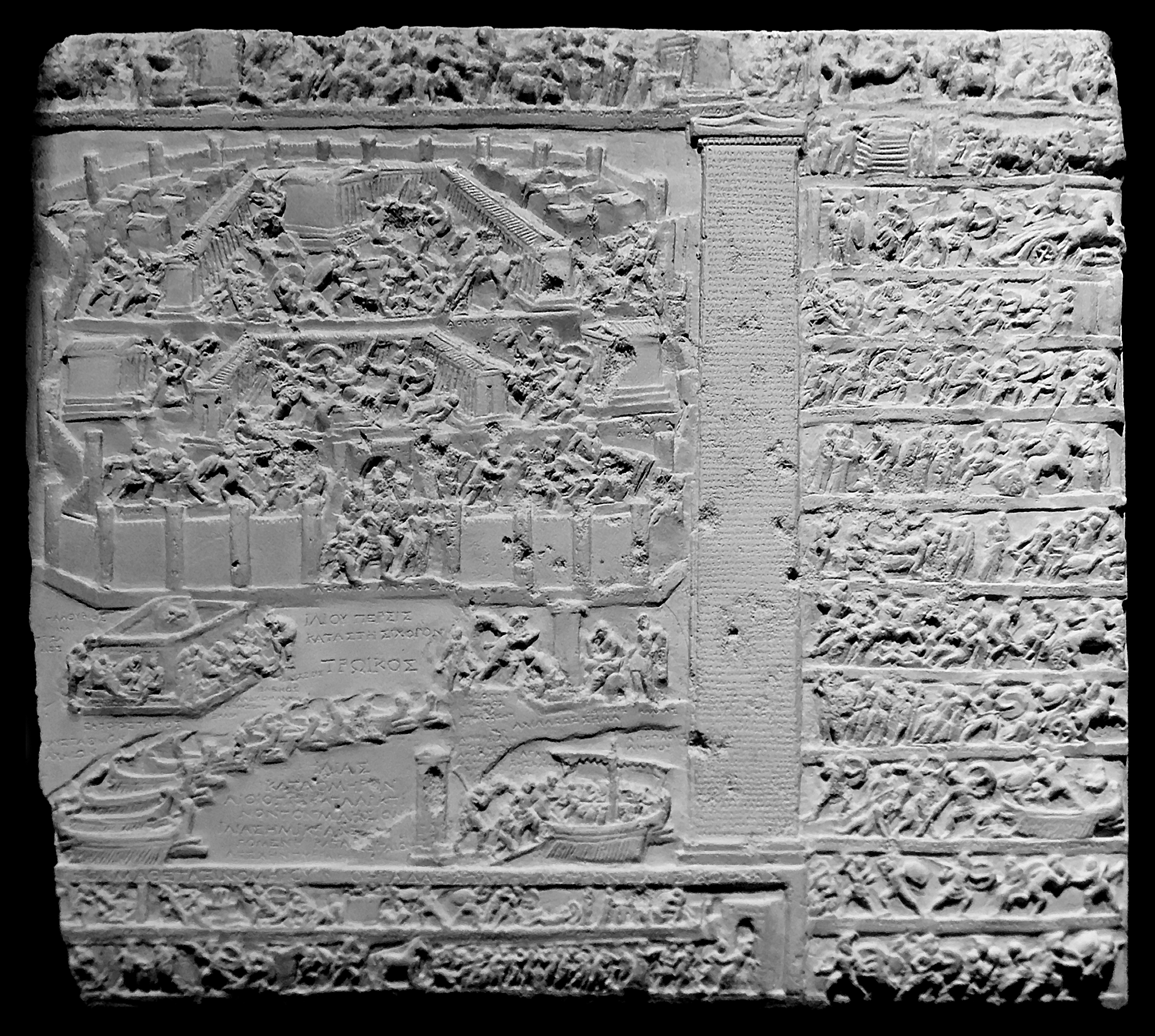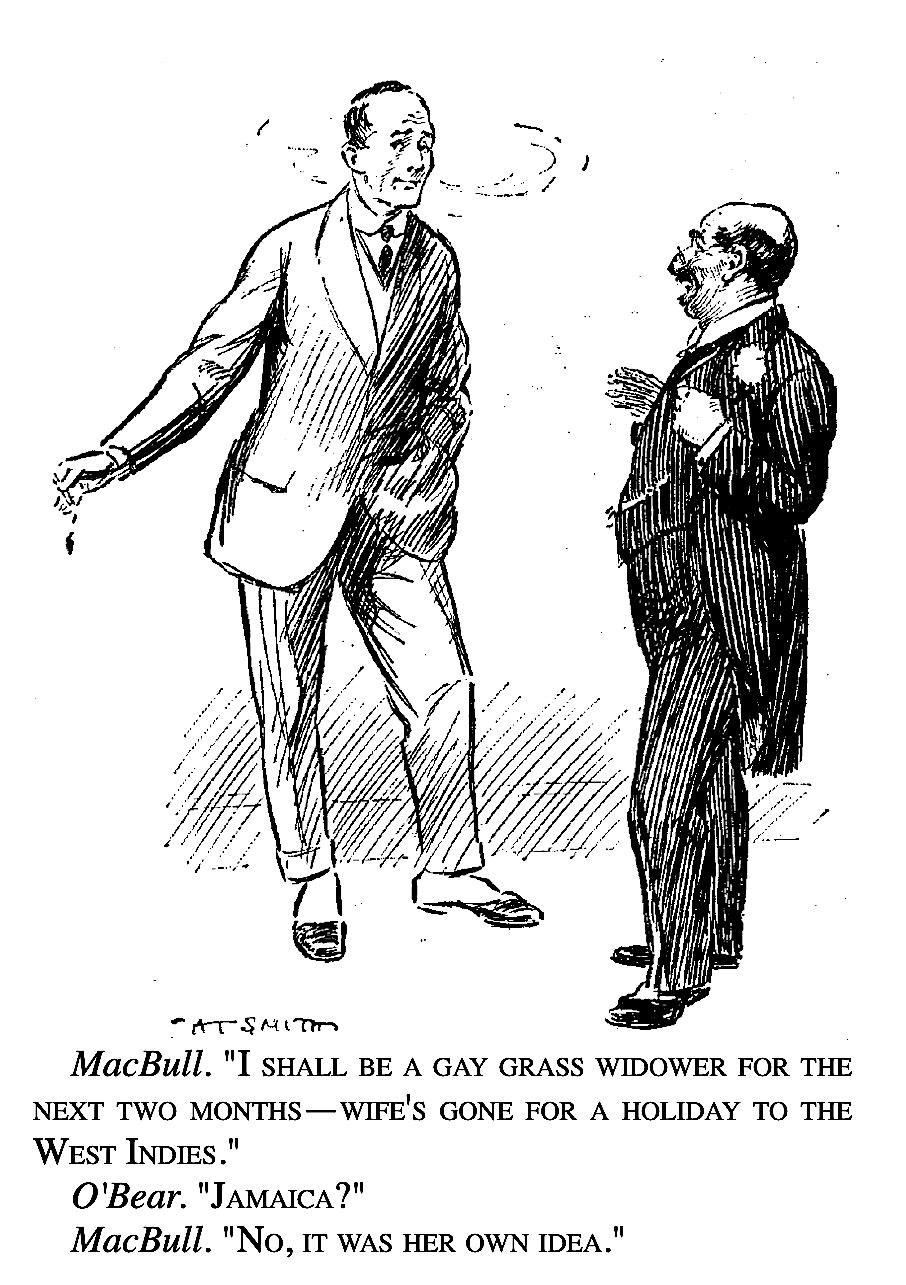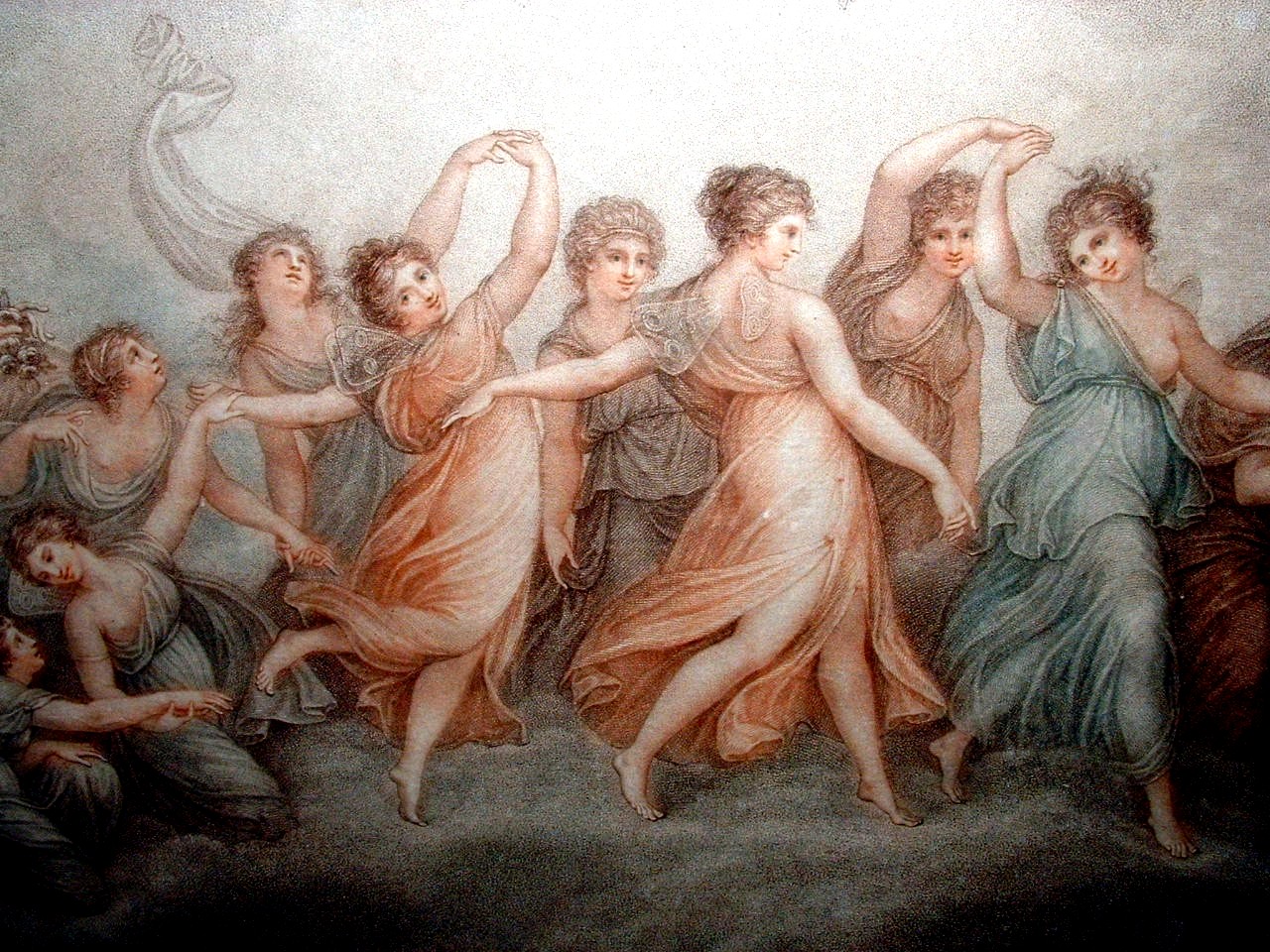|
Antistrophe
Antistrophe (, "a turning back") is the portion of an ode sung by the chorus in its returning movement from west to east in response to the strophe, which was sung from east to west. Characteristics Usage as a literary device It has the nature of a reply and balances the effect of the strophe. Thus, in Gray's ode called "The Progress of Poesy" (excerpt below), the strophe, which dwelt in triumphant accents on the beauty, power and ecstasy verse, is answered by the antistrophe, in a depressed and melancholy key: When the sections of the chorus have ended their responses, they unite and close in the epode, thus exemplifying the triple form, in which the ancient sacred hymns of Greece were coined, from the days of Stesichorus onwards. As Milton says: " strophe, antistrophe and epode were a kind of stanza framed for the music then used with the chorus that sang". Other semantic usage ''Antistrophe'' was also a kind of ancient dance Dance is an The arts, art fo ... [...More Info...] [...Related Items...] OR: [Wikipedia] [Google] [Baidu] |
Strophe
A strophe () is a poetic term originally referring to the first part of the ode in Ancient Greek tragedy, followed by the antistrophe and epode. The term has been extended to also mean a structural division of a poem containing stanzas of varying line length. Strophic poetry is to be contrasted with poems composed line-by-line non-stanzaically, such as Greek epic poems or English blank verse, to which the term '' stichic'' applies. In its original Greek setting, "strophe, antistrophe and epode were a kind of stanza framed only for the music", as John Milton wrote in the preface to '' Samson Agonistes'', with the strophe chanted by a Greek chorus as it moved from right to left across the scene. Etymology Strophe (from Greek στροφή, "turn, bend, twist") is a concept in versification which properly means a turn, as from one foot to another, or from one side of a chorus to the other. Poetic structure In a more general sense, the strophe is a pair of stanzas of alte ... [...More Info...] [...Related Items...] OR: [Wikipedia] [Google] [Baidu] |
Epode
According to one meaning of the word, an epode is the third part of an ancient Greek choral ode that follows the strophe and the antistrophe and completes the movement. The word epode is also used to refer to the second (shorter) line of a two-line stanza of the kind composed by Archilochus and Hipponax in which the first line consists of a dactylic hexameter or an iambic trimeter.West, M. L. (1987)''An Introduction to Greek Metre'' Oxford.; p. 31. (See Archilochian.) It can also be used (as in Horace's Epodes) to refer to poems written in such stanzas. Evolution In the performance of a choral ode, at a certain point in time the choirs, which had previously chanted to the right of the altar or stage, and then to the left of it, combined and sang in unison, or permitted the '' coryphaeus'' to sing for them all, while standing in the centre. The epode soon took its place in choral poetry, which it lost when that branch of literature declined. But it extended beyond the ode, and ... [...More Info...] [...Related Items...] OR: [Wikipedia] [Google] [Baidu] |
Stesichorus
Stesichorus (; , ''Stēsichoros''; c. 630 – 555 BC) was a Greek Greek lyric, lyric poet native of Metauros (Gioia Tauro today). He is best known for telling epic stories in lyric metres, and for some ancient traditions about his life, such as his opposition to the tyrant Phalaris, and the blindness he is said to have incurred and cured by composing verses first insulting and then flattering to Helen of Troy. He was ranked among the nine lyric poets esteemed by the scholars of Hellenistic Alexandria, and yet his work attracted relatively little interest among ancient commentators, so that remarkably few fragments of his poetry now survive. As David Campbell notes: "Time has dealt more harshly with Stesichorus than with any other major lyric poet." Recent discoveries, recorded on Egyptian papyrus (notably and controversially, the Lille Stesichorus),P.J. Parsons, "The Lille Stesichorus", ''Zeitschreift für Papyrologie und Epigraphik'' Vol. 26 (1977), pages 7–36 have led to some i ... [...More Info...] [...Related Items...] OR: [Wikipedia] [Google] [Baidu] |
Figures Of Speech
A figure of speech or rhetorical figure is a word or phrase that intentionally deviates from straightforward language use or literal meaning to produce a rhetorical or intensified effect (emotionally, aesthetically, intellectually, etc.). In the distinction between literal and figurative language, figures of speech constitute the latter. Figures of speech are traditionally classified into '' schemes'', which vary the ordinary sequence of words, and '' tropes'', where words carry a meaning other than what they ordinarily signify. An example of a scheme is a polysyndeton: the repetition of a conjunction before every element in a list, whereas the conjunction typically would appear only before the last element, as in "Lions and tigers and bears, oh my!"—emphasizing the danger and number of animals more than the prosaic wording with only the second "and". An example of a trope is the metaphor, describing one thing as something it clearly is not, as a way to illustrate by compar ... [...More Info...] [...Related Items...] OR: [Wikipedia] [Google] [Baidu] |
Thomas Gray
Thomas Gray (26 December 1716 – 30 July 1771) was an English poet, letter-writer, and classics, classical scholar at Cambridge University, being a fellow first of Peterhouse then of Pembroke College, Cambridge, Pembroke College. He is widely known for his ''Elegy Written in a Country Churchyard,'' published in 1751. Gray was a Self-criticism, self-critical writer who published only 13 poems in his lifetime, despite being very popular. He was even offered the position of Poet laureate, Poet Laureate in 1757 after the death of Colley Cibber, though he declined. Early life and education Thomas Gray was born in Cornhill, London. His father, Philip Gray, was a scrivener and his mother, Dorothy Antrobus, was a milliner. He was the fifth of twelve children, and the only one to survive infancy.John D. Baird, 'Gray, Thomas (1716–1771)', ''Oxford Dictionary of National Biography'' (Oxford University Press, 2004Accessed 21 February 2012/ref> An 1803 newspaper article including a biog ... [...More Info...] [...Related Items...] OR: [Wikipedia] [Google] [Baidu] |
John Milton
John Milton (9 December 1608 – 8 November 1674) was an English poet, polemicist, and civil servant. His 1667 epic poem ''Paradise Lost'' was written in blank verse and included 12 books, written in a time of immense religious flux and political upheaval. It addressed the fall of man, including the temptation of Adam and Eve by the fallen angel Satan, and God's expulsion of them from the Garden of Eden. ''Paradise Lost'' elevated Milton's reputation as one of history's greatest poets. He also served as a civil servant for the Commonwealth of England under its Council of State and later under Oliver Cromwell. Milton achieved fame and recognition during his lifetime. His celebrated '' Areopagitica'' (1644) condemning pre-publication censorship is among history's most influential and impassioned defences of freedom of speech and freedom of the press. His desire for freedom extended beyond his philosophy and was reflected in his style, which included his introduction of new words ... [...More Info...] [...Related Items...] OR: [Wikipedia] [Google] [Baidu] |
Stanza
In poetry, a stanza (; from Italian ''stanza'', ; ) is a group of lines within a poem, usually set off from others by a blank line or indentation. Stanzas can have regular rhyme and metrical schemes, but they are not required to have either. There are many different forms of stanzas. Some stanzaic forms are simple, such as four-line quatrains. Other forms are more complex, such as the Spenserian stanza. Fixed verse poems, such as sestinas, can be defined by the number and form of their stanzas. The stanza has also been known by terms such as ''batch'', ''fit'', and ''stave''. The term ''stanza'' has a similar meaning to ''strophe'', though ''strophe'' sometimes refers to an irregular set of lines, as opposed to regular, rhymed stanzas. Even though the term "stanza" is taken from Italian, in the Italian language the word "strofa" is more commonly used. In music, groups of lines are typically referred to as '' verses''. The stanza in poetry is analogous with the paragrap ... [...More Info...] [...Related Items...] OR: [Wikipedia] [Google] [Baidu] |
Dance
Dance is an The arts, art form, consisting of sequences of body movements with aesthetic and often Symbol, symbolic value, either improvised or purposefully selected. Dance can be categorized and described by its choreography, by its repertoire of movements or by its History of dance, historical period or List of ethnic, regional, and folk dances by origin, place of origin. Dance is typically performed with Music, musical accompaniment, and sometimes with the dancer simultaneously using a musical instrument themselves. Two common types of group dance are Concert dance, theatrical and Participation dance, participatory dance. Both types of dance may have special functions, whether social, ceremonial, Competitive dance, competitive, Erotic dance, erotic, War dance, martial, Sacred dance, sacred or Liturgical dance, liturgical. Dance is not solely restricted to performance, as dance is used as a form of exercise and occasionally training for other sports and activities. Dance perf ... [...More Info...] [...Related Items...] OR: [Wikipedia] [Google] [Baidu] |
Ancient Greek Dances
Ancient history is a time period from the beginning of writing and recorded human history through late antiquity. The span of recorded history is roughly 5,000 years, beginning with the development of Sumerian cuneiform script. Ancient history covers all continents inhabited by humans in the period 3000 BCAD 500, ending with the expansion of Islam in late antiquity. The three-age system periodises ancient history into the Stone Age, the Bronze Age, and the Iron Age, with recorded history generally considered to begin with the Bronze Age. The start and end of the three ages vary between world regions. In many regions the Bronze Age is generally considered to begin a few centuries prior to 3000 BC, while the end of the Iron Age varies from the early first millennium BC in some regions to the late first millennium AD in others. During the time period of ancient history, the world population was exponentially increasing due to the Neolithic Revolution, which was in full progr ... [...More Info...] [...Related Items...] OR: [Wikipedia] [Google] [Baidu] |





